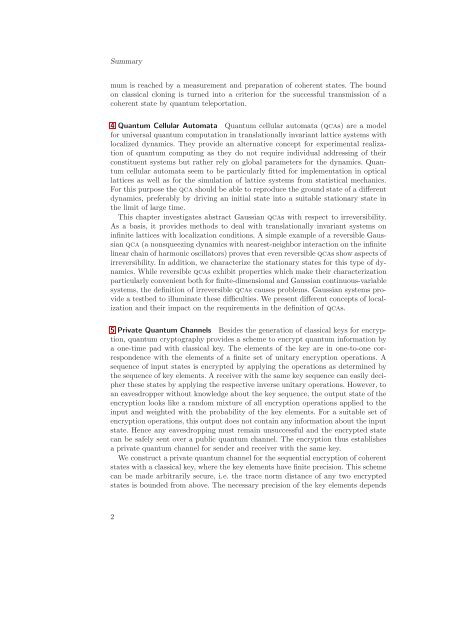Quantum Information Theory with Gaussian Systems
Quantum Information Theory with Gaussian Systems
Quantum Information Theory with Gaussian Systems
You also want an ePaper? Increase the reach of your titles
YUMPU automatically turns print PDFs into web optimized ePapers that Google loves.
Summary<br />
mum is reached by a measurement and preparation of coherent states. The bound<br />
on classical cloning is turned into a criterion for the successful transmission of a<br />
coherent state by quantum teleportation.<br />
4 <strong>Quantum</strong> Cellular Automata <strong>Quantum</strong> cellular automata (qcas) are a model<br />
for universal quantum computation in translationally invariant lattice systems <strong>with</strong><br />
localized dynamics. They provide an alternative concept for experimental realization<br />
of quantum computing as they do not require individual addressing of their<br />
constituent systems but rather rely on global parameters for the dynamics. <strong>Quantum</strong><br />
cellular automata seem to be particularly fitted for implementation in optical<br />
lattices as well as for the simulation of lattice systems from statistical mechanics.<br />
For this purpose the qca should be able to reproduce the ground state of a different<br />
dynamics, preferably by driving an initial state into a suitable stationary state in<br />
the limit of large time.<br />
This chapter investigates abstract <strong>Gaussian</strong> qcas <strong>with</strong> respect to irreversibility.<br />
As a basis, it provides methods to deal <strong>with</strong> translationally invariant systems on<br />
infinite lattices <strong>with</strong> localization conditions. A simple example of a reversible <strong>Gaussian</strong><br />
qca (a nonsqueezing dynamics <strong>with</strong> nearest-neighbor interaction on the infinite<br />
linear chain of harmonic oscillators) proves that even reversible qcas show aspects of<br />
irreversibility. In addition, we characterize the stationary states for this type of dynamics.<br />
While reversible qcas exhibit properties which make their characterization<br />
particularly convenient both for finite-dimensional and <strong>Gaussian</strong> continuous-variable<br />
systems, the definition of irreversible qcas causes problems. <strong>Gaussian</strong> systems provide<br />
a testbed to illuminate these difficulties. We present different concepts of localization<br />
and their impact on the requirements in the definition of qcas.<br />
5 Private <strong>Quantum</strong> Channels Besides the generation of classical keys for encryption,<br />
quantum cryptography provides a scheme to encrypt quantum information by<br />
a one-time pad <strong>with</strong> classical key. The elements of the key are in one-to-one correspondence<br />
<strong>with</strong> the elements of a finite set of unitary encryption operations. A<br />
sequence of input states is encrypted by applying the operations as determined by<br />
the sequence of key elements. A receiver <strong>with</strong> the same key sequence can easily decipher<br />
these states by applying the respective inverse unitary operations. However, to<br />
an eavesdropper <strong>with</strong>out knowledge about the key sequence, the output state of the<br />
encryption looks like a random mixture of all encryption operations applied to the<br />
input and weighted <strong>with</strong> the probability of the key elements. For a suitable set of<br />
encryption operations, this output does not contain any information about the input<br />
state. Hence any eavesdropping must remain unsuccessful and the encrypted state<br />
can be safely sent over a public quantum channel. The encryption thus establishes<br />
a private quantum channel for sender and receiver <strong>with</strong> the same key.<br />
We construct a private quantum channel for the sequential encryption of coherent<br />
states <strong>with</strong> a classical key, where the key elements have finite precision. This scheme<br />
can be made arbitrarily secure, i.e. the trace norm distance of any two encrypted<br />
states is bounded from above. The necessary precision of the key elements depends<br />
2
















